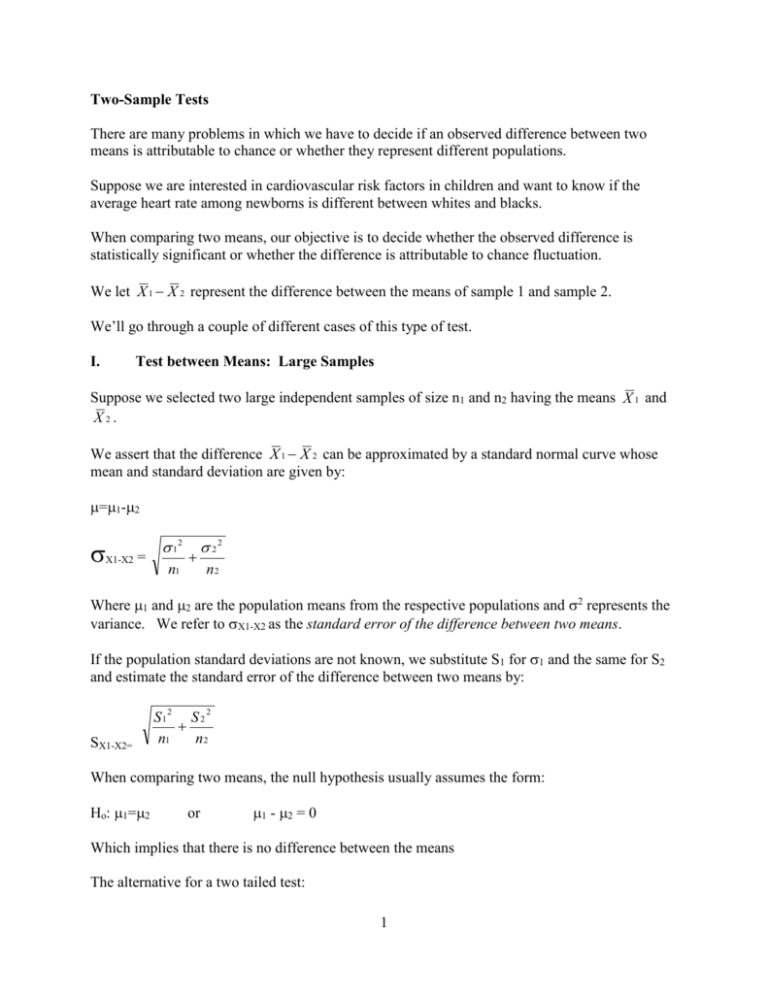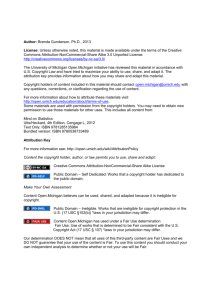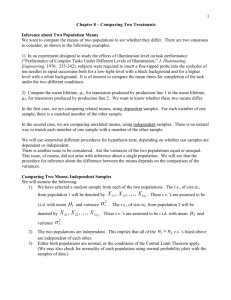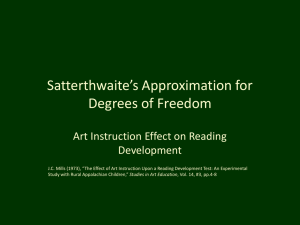Word
advertisement

Two-Sample Tests There are many problems in which we have to decide if an observed difference between two means is attributable to chance or whether they represent different populations. Suppose we are interested in cardiovascular risk factors in children and want to know if the average heart rate among newborns is different between whites and blacks. When comparing two means, our objective is to decide whether the observed difference is statistically significant or whether the difference is attributable to chance fluctuation. We let X 1 X 2 represent the difference between the means of sample 1 and sample 2. We’ll go through a couple of different cases of this type of test. I. Test between Means: Large Samples Suppose we selected two large independent samples of size n1 and n2 having the means X 1 and X2. We assert that the difference X 1 X 2 can be approximated by a standard normal curve whose mean and standard deviation are given by: =1-2 X1-X2 = 12 n1 22 n2 Where 1 and 2 are the population means from the respective populations and 2 represents the variance. We refer to X1-X2 as the standard error of the difference between two means. If the population standard deviations are not known, we substitute S1 for 1 and the same for S2 and estimate the standard error of the difference between two means by: SX1-X2= S12 S 2 2 n1 n2 When comparing two means, the null hypothesis usually assumes the form: Ho: 1=2 or 1 - 2 = 0 Which implies that there is no difference between the means The alternative for a two tailed test: 1 H1: 1 2 or 1 - 2 0 If it is a one-tailed test: H1: 1 > 2 or 1 - 2 > 0 The Z value in this case (recall we can use the standard normal here since the sample size is large so that the normal distribution can be used as an approximate). Z= X1 X 2 S 1 / n1 S 2 2 / n 2 2 Which is a random variable following the normal distribution. Back to our example: Suppose we collect the following data on heart rate among newborns: Mean (beats per minute) 129 133 Race White Black sd 11 12 n 218 156 And we want to test the hypothesis that the average heart rate for white newborns is different than the average heart rate for black newborns. Ho: w=b H1: w b or w - b = 0 or w - b 0 4 3.290 .555 .923 1.216 112 / 218 12 2 / 156 Using Excel: =norm.s.dist(-3.289,1) gives the p-value associated with this: .00050. Z= 129 133 4 There is only a .05% chance that we could get this large of a difference between the sample means if, indeed, the population means were equal. Thus we would reject the null hypothesis and conclude that there is evidence from our sample that the average heart rates are different between white and black newborns. II. Test between Means: Small Samples If our samples come from populations that can be approximated by the standard normal curve and if 1 = 2= (i.e., the standard deviations of the two populations are equal), a small sample test of the differences between two means may be based on the t distribution. Then our test statistic becomes: 2 t X1 X 2 ( x1 X 1) ( x 2 X 2) 2 n1 n 2 2 2 1 1 * n1 n 2 Note that this “kind of” looks like (X-)//n). In the denominator note that there is something like the variance of each variable in there, and we are dividing by n1+n2. By definition (x1-X1b)2 = (n1-1)S12 and (x2-X2b)2 = (n2-1)S22 This equation can be “simplified” to be: t X1 X 2 (n1 1) S 1 2 (n 2 1) S 2 2 1 1 * n1 n 2 2 n1 n 2 This is known as the “pooled variance t-test” for the difference between two means. Note that we are calculating something that looks like the two variances combined in the equation. Since n1-1 of the deviations from the mean are independent in S12 and n2-1 of the deviations from the mean are independent in S22, we have (n1-1) + (n2-1) or (n1+n2-2) degrees of freedom. Thus the above equation represents the t distribution with (n1+n2-2) degrees of freedom. Suppose we want to know if there is a difference in costs between patients in our downtown vs. suburban hospital. We take a sample of both groups and calculate the following: Average Cost Hospital Downtown suburban St Dev 7,033 8,308 15,072 14,068 N 21 22 Is there evidence that the downtown cost is different from the suburban cost? Ho: d=r H1: r ≠ m t 15072 14068 1003.7 .427 2352.9 (21 1)7033 (22 1)8308 1 1 * 21 22 2 21 22 The pvalue: =t.dist.2t(.427,41) gives a pvalue of .67, so there is about a 67 percent chance of getting two sample means this far apart if the population means were really equal. So at any reasonable value of alpha we would fail to reject the null hypothesis and conclude there is no evidence in this sample that costs are different between the two hospitals. 2 2 3 Notice that with the t.dist function we always compare the probability to all of alpha. Since we specify a one tail (RT) or two tail (2t) test, Excel always gives the pvalue that you compare to alpha. If we do =t.dist.Rt(.427,41), it gives .335 which is half of what .2t gives. So with a two tailed test, it doubles the pvalue and you compare it to alpha. When using norm.s.dist() with a two tailed test we compare the resulting probability to HALF of alpha (eg, .025 if alpha = .05), and we compare the resulting probability to all of alpha if it is a one tailed test. Note that in Excel under the Tools, data analysis, tabs there are canned formulas for the z-test for different sample means, t-tests under equal variances and t-tests under unequal variances. These are OK to use as a check on your work, but for this section of the homework, I want you to calculate the z/t values on your own. Afterwards you are free to use them. III. F-Test for the difference between two variances The above t-test made the assumption that the two samples have a common variance. In order to be complete, this assumption must be tested. Assuming that independent random samples are selected from two populations, test for equality of two population variances are usually based on the ratio S12/S22 or S22/S12. If the two populations from which the samples were selected are normally distributed, then the sampling distribution of the variance ratio is a continuous distribution called the F distribution. The F distribution depends on the degrees of freedom given by n1-1 and n2-1 where n1 and n2 are the sample sizes that S12 and S22 are based. The F- distribution looks as follows: It is skewed to the right, but as the degrees of freedom increases it becomes more symmetrical and approaches the normal distribution. The easiest way to conduct the test is to construct the ratio such that the large of the two variances are on the top. That way you are always looking at the upper tail and do not need to worry about the lower tail. 4 Basically what is going on is you are comparing the two variances and asking “is one bigger than the other?” If the variances are equal then this will equal 1, if the variances are “different” then this ratio will be something greater than 1. So the question is how far away is too far away? That is what the F distribution tells us. Under the Null the variances are equal and so the ratio should equal one, but there is some probability that the ratio will be larger than 1, thus if it is too unlikely for the variances to be equal we reject the null and conclude the variances are not equal: Suppose we are interested in examining the mean stays experienced by two populations from which we have drawn a random sample of size n1=6 and n2=8. Based on this random sample, suppose we found that S12 =12 days and S22 = 10 days. Before testing the significance of the observed difference between the two mean stays, we should examine the assumption that 12 = 22 by: Ho: 12=22 H1: 12 22 F = 12/10 = 1.2 Using =.05. Here there are 5 degrees of freedom in the numerator and 7 degrees of freedom in the denominator. Using the Excel function F.DIST.rt(F,df1,df2) or =F.DIST.rt(1.2,5,7)=.397. Thus if the null is true that the variances are equal, there is a 40 percent chance we could get two sample variances that were this far apart from each other. Since this is a two tailed test, we compare this value to half of alpha. Thus, we would not reject our null hypothesis and conclude that there is no evidence that the two variances are different. Or going back to or cost example above: In that case our F stat would be: F=83082/70332 = 1.396 F.dist.rt(1.396,21,20) = .230. There is a 23% chance of getting sample variances this far apart if the population variances really were equal so we fail to reject the null. Note if we reject the null, then we have to go to a more complicated form of the t-test. We are not going to go through the details of these tests, but the logic is the same. IV. Tests between two samples: Categorical Data This section deals with how we can test for the difference between two proportions from different samples. We might be interested in the difference in the proportion of smokers and nonsmokers who suffer from heart disease or lung cancer, etc. Our Null Hypothesis would be: Ho: P1=P2 Where P1 and P2 are the population proportions. Letting p1 and p2 represent the sample proportions, we can use p1 - p2 to evaluate the difference between the proportions. 5 1. Z test for the difference between two proportions One way to do this test is using the standard normal distribution. Here our Z statistic is: Z x1 x 2 n1 n 2 1 1 P * (1 P * ) n1 n 2 Where: x1/n1 the proportion of successes from sample 1 and x1/n1 is the sample of successes from sample 2 and x1 x 2 P* n1 n 2 Note that this is similar to the formula we used to test hypotheses on a single sample proportion, the denominator is using the combined proportion to estimate the standard error of the difference in the sample proportions. EX: in 2005 a sample of 200 low income families (less than 200 percent of the poverty line) was taken and it was found that 43 of them have children who have no health insurance. In 2014 a similar survey of 250 families was taken and 38 were found not to have insurance. Is there evidence from these samples that the proportion of low income children without insurance has decreased? Ho: P14≥P05 H1: P14<P05 P* 38 43 .18 250 200 So: 38 43 250 200 Z 1.73 1 1 .18(1 .18) 250 200 Norm.s.dist(-1.73,1) .042. So what do we conclude? 6 2. 2 test for the difference between two proportions An alternative to the Z test, is the 2 (chi-square) test. This starts by laying out a contingency table of the outcomes: Successes Failures Totals 2005 43 157 200 We want to test the Null: Against 2014 38 212 250 Total 81 369 450 Ho: P2005 = P2014 H1: P2005 P2014 I will come back to this, but note we are setting this up as a two tailed test The 2 test statistic takes the following form: 2 ( f 0 fe) 2 fe AllCells where f0 is the observed frequency, in a particular cell of the 2x2 table fe is the theoretical, or expected frequency in a particular cell if the null hypothesis is true. This test approximately follows a chi-square distribution with 1 degree of freedom. I will discuss the chi-square distribution in a minute. To understand what fe is, assume the null hypothesis is true, then the sample proportions computed from each of the two groups would differ from each other only by chance and would each provide an estimate of the common population parameter, p. In such a situation, a statistic that pools or combines these two separate estimates together into one overall estimate of the population parameter provides more information than either of the two separate estimates could provide by itself. This statistic, P*, is: x1 x 2 P* n1 n 2 7 To obtain the expected frequency for each cell pertaining to successes (the cells in the first row of the table), the sample size for a group is multiplied by P* to obtain the expected frequency for each cell. For each cell in the second row the sample size is multiplied by (1-P*). In our example: 43 38 P* .18 200 250 2005 Actual 2005 Expected 2014 Actual 43 36 38 45 157 200 164 200 212 250 205 250 Successes Failures Totals f0 fe 43 38 157 212 (f0-fe)2 (f0-fe) 36 45 164 205 7 -7 -7 7 2014 Expected (f0-fe)2/fe 49 49 49 49 Sum= 1.36 1.09 0.30 0.24 2.99 This is our test statistic, 2.99, note that what this is doing is taking the sum of the squared difference between the actual proportion in each cell from the predicted proportion assuming the null is true. So if any of these are “way off” then the test statistic will be “large” while if they are not off the test statistic will be “small”. The question now is what is large and what is small. This is where the 2 distribution comes in. It turns out that if we have the sum of n statistically independent standard normal variables, then this sum follows the 2 distribution. The probability density function for the chi-square distribution looks as follows: 8 The degrees of freedom are calculated as follows: DF = (r-1)(c-1), where r is the number of rows in the table, and c is then number of columns. So in our 2x2 table df = 1. In this case to get the pvalue we use: =CHISQ.DIST.RT(x,df) or =CHISQ.DIST.RT(2.99,1)=.084 to get the pvalue. So if the null is true and the two proportions are equal, then there is a 8.4 percent chance of getting sample proportions this far from each other. Thus since .084>.05(α) we fail to reject the null hypothesis and conclude that there is not evidence that the two populations have a different rate of uninsured. But note that since we are summing squared differences, we cannot distinguish between those above and those below the expected value, so technically we can only conclude here that the proportions are different. The Z-test and 2 tests will usually give the same answers; they are just two different ways of doing the same thing. The nice thing about the 2 test is it is generalizable to more than two proportions. The logic is exactly the same. V. 2 test for independence What we did above was show the 2 test for the difference between two (or more) proportions. This can be generalized as a test of independence in the joint responses to two categorical 9 variables. This is something similar to the correlation coefficient (but applied to categorical data) in that it tells you if there is a relationship between two variables. The null and alternative hypotheses are as follows: Ho: the two categorical variables are independent (there is no relationship between them) H1: The variables are dependent (there is a relationship between them) We use the same equation as before: 2 ( f 0 fe) 2 fe AllCells Suppose we are interested in the relationship between education and earnings for registered nurses. We collect data for 550 randomly chosen RNs and get the following table: Earnings < 60k 60k-70k 70k+ Total AD 80 72 48 200 Level of Education Diploma BS 65 44 34 53 31 123 130 220 Total 189 159 202 550 So our null would be that there is no relationship between education and earnings, and the alternative is that there is a relationship between the two. To obtain fe in this case we go back to the probability theory. If the null hypothesis is true, the multiplication rule for independent events can be used to determine the joint probability or proportion of responses expected for any cell combination. That is, P(A and B) = P(A|B)*P(B) – the joint probability of events A and B is equal to the probability of A, given B, times the probability of B. So, suppose we want to know the probability of drawing a Heart and a face card from a normal deck of cards, let Heart = A, Face =B, then P(H and F) = P(H|F)*P(F), there are 4*4 or 16 face cards in a deck, 4 of them hearts so P(H|F) = 4/16 or 1/4. Then the probability of Face is 16/52=4/13. So P(H and F) = 1/4*4/13 = 4/52 or 1/13. But note that the events Heart and Face are independent of each other since P(H) = 13/52=1/4 and P(H|F)=1/4. That is, knowing the card is a face card does not change the probability of getting a heart. Then the joint probability formula simplifies to: P(A and B) = P(A)*P(B) when A and B are independent. But suppose we had a deck of cards that had an extra king of hearts and the king of spades was missing. Then P(H) ≠ P(H|F). Knowing that the card is a face card would change the probability of drawing a heart. 10 So back to the example above: assuming independence, if we want to know the probability of being in the top left cell – representing having an associate’s degree and earning less than 60k – this will be the product of the two separate probabilities: P(AD and < 60k) = P(AD)*P(<60k) P(AD) = 200/550 = .3636 P(<60k) = 189/550 = .3436 So if these two guys are independent then P(AD and < 60k)= .3636*.3436 = .1249. This is the predicted proportion. The observed proportion is 80/550=.1455. Basically we want to compare the actual vs. predicted proportions for each cell. If the predicted proportion was .1249, we would expect 550*.1249 = 68.7 RNs to be in this cell To find the expected number in each cell: fe = (row total x column total)/n For this example: 200*189/550 = 68.7 So to calculate the 2 statistic: AD/<60k AD/60-70 AD/70k+ Dip/<60k Dip/60-70 Dip/70k+ BS/<60k BS/60-70 BS/70k+ f0 80 72 48 65 34 31 44 53 123 fe 68.7 57.8 73.5 44.7 37.6 47.7 75.6 63.6 80.8 (f0-fe) 11.3 14.2 -25.5 20.3 -3.6 -16.7 -31.6 -10.6 42.2 (f0-fe)2 127.7 201.6 650.3 412.1 13.0 278.9 998.6 112.4 1780.8 (f0-fe)2/fe 1.86 3.49 8.85 9.22 0.34 5.85 12.21 1.77 22.04 Sum= 65.63 In this case we have c=3 and r=3, so there are 2*2 =4 degrees of freedom. The pvalue is very close to zero (=CHISQ.DIST.RT(65.63,4)=1.9x10-13). Thus we would reject the null hypothesis and conclude that there is evidence of a relationship between earnings and education among RNs. Note that just like the correlation coefficient this test does not tell you anything about the relationship between the two variables, just that one appears to exist. 11








